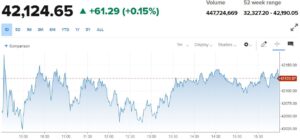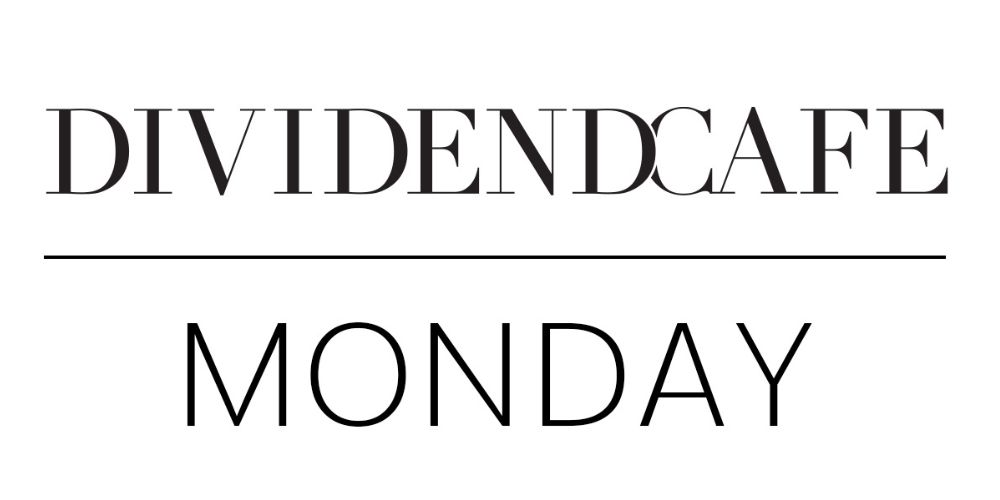Dear Valued Clients and Friends –
It’s a classic Monday Dividend Cafe today – a true around the horn (as it is supposed to be).
Dividend Cafe did a recent history analysis of the Fed, looked at the recent rate cut, and suggested a few things that most commentators are overlooking right now when it comes to understanding what comes next. The written version is here (my favorite), the video is here, and the podcast is here.
Off we go…
|
Subscribe on |
Market Action
- The market opened up +70 points today and, after dropping just a hundred points or so a couple of times, closed right around that opening spot. Both the Dow and S&P saw record highs today.
- The Dow closed up +61 points (+0.15%), with the S&P 500 up +0.28% and the Nasdaq +0.14%.

*CNBC, DJIA, Sept. 23, 2024
- Only 32% of semiconductor companies are even above their 200-day moving averages, and yet markets are making new highs. That was not on my bingo card. And with only 53% of the entire Russell 1000 Technology Sector above its 200-day moving average, we very clearly have a high dispersion of results within the tech space right now.
- The 2020-2022 era of shining objects will one day have the infamy it deserves to have, right up there alongside the way we talk about the dotcom era of the late 1990s. But when a company with a near household brand like 23 and Me can go from a $6 billion value to $0 (well, a $7 million value, with $7 million of cash on hand, soooo …) you know that it is NOT true that all lower prices mean more value. They do so when the company is not a shiny object. However, the problem with shiny objects is that they apparently impede some people’s ability to see.
- The ten-year bond yield closed today at 3.75%, up two basis points on the day.
- Top-performing sector for the day: Energy (+1.31%)
- Bottom-performing sector for the day: Health Care (-0.25%)
- Banks represented 30% of corporate debt at the time of the financial crisis. The number vacillates between 15% and 20% now, as a huge amount of that market share has been taken by private credit. The market share of non-bank lending that has gone from the bond market to private credit is even more pronounced. I will be meeting with three private credit lenders we work with next week who all happen to be in the top five of total market share in the space (Blackstone, Cliffwater, and Apollo) and will have much more to say about the state of private credit at the end of next week.
Top News Stories
- The Israel/Hezbollah conflict is escalating rapidly; Israeli air strikes are continuing, key Hezbollah leaders at the terrorist group have been taken out, and what comes next remains unknown. But the Pentagon announced today it is sending additional troops, a dozen warships, and fighter-jet squadrons to the region.
- As always, talks of a government shutdown proved to be media hype, and a short-term funding agreement was reached Sunday that will last through the election but not through the lame-duck session of Congress after the election.
Public Policy
- The extension of funding agreed to last night by House and Senate leaders (expected to be voted on and agreed to by the White House prior to next Monday) does not give the White House $12 billion of funding for the VA (what they were requesting), nor does it have the SAVE Act tightening proof-of-citizenship before voting (what many Republicans were requesting). It does add $230 million of funding for the Secret Service, which hopefully enables the funding for someone to, ummmm, look on top of buildings nearby high-profile targets.
- Presidential candidate Donald Trump is making the Chinese purchase of American farmland a campaign issue as of late. This policy issue could receive fresh attention in the campaign’s final weeks if it ends up resonating with voters. Studies show that it has happened in recent years, though likely not in very large quantities, but also with a very opaque reporting system and awareness (in other words, it could be much higher than is understood).
- Speaking of China, the Biden administration announced a ban on Chinese software in internet-connected automobiles in the U.S.
- The possibility of Nebraska changing their system from electoral college votes going by Congressional district to a winner-take-all state really intensifies the possibility of a 269-269 tie in the Electoral College. Maine and Nebraska are the only two states that do it this way, and 48 states are winner-take-all. The congressional district around Omaha went for Trump once and against Trump the other time in the last two elections, whereas the rest of Nebraska is overwhelmingly red. If Nebraska goes “winner take all,” and Harris wins PA, MI, and WI, while Trump wins AZ, NC, NV, and GA, it would be 269-269.
- It is worth noting that NC is appearing more and more to be a battleground state and not a gimme for former President Trump.
- Though I get very different theories of the case from all sorts of people that I genuinely trust and respect, Pennsylvania appears to be more favorable in the polling for Harris than it previously had been
- In the event of a tie, the race is sent to the House of Representatives. That would surely be a great moment for our country.
Economic Front
- You cannot have a “strong economy” and a “weak labor market” – and you cannot have a “weak economy” and a “strong labor market.” There may be a very brief period of two ships crossing each other in the data, but fundamentally, if one believes labor is good – hiring is strong, access to jobs strong, layoffs are low, and wages are good – then one believes the economy is good. Strong labor markets happen because profit conditions are good and/or promising, so optimism and opportunity are available to hire and resource for more of these good things. Inversely, weak labor conditions both signify and reinforce a downward pull on economic conditions (declining optimism and production of goods and services). So right now, people have a choice to make: If they believe in a strong economy, weak labor narrative, OR if they believe in a weak economy, strong labor narrative, they will have to decide which one is changing to be in line with the other. If labor conditions are weakening, the economy will soon be, as well (meaning it will soon show up in the data). I see a mixed bag of data out there with one particular data point creating the most problems for [short-term] economic bears: The very low layoff rate. Employers are not laying people off. At least not yet.
- Speaking of mixed signals, Manufacturing PMI contracted (47, lower even than the 47.9 from last month), while Services expanded (55.4 on the month). As a reminder, PMI is benchmarked to 50 as the flatline, with anything below 50 signaling contraction and anything above 50 signaling expansion. New Orders fell at the fastest rate in almost two years.
Housing & Mortgage
- Housing starts picked up a bit in August, hitting 1.35 for August (annualized) vs. 1.24 for July (where Hurricane Beryl may have played a role in an even lower number than expected). Permits did reach a five-month high in August. New housing supply and even the beginning of new housing.
- New housing starts notwithstanding, sales of existing homes declined another -2.5% in August (annualized rate), and are now down -4.2% versus a year ago (and to reinforce the base effect, a year ago, things were really down).
- The 30-year mortgage rate is down over 1% from its peak high in this cycle but remains 3-4% over the levels of early 2022.
Federal Reserve
- As mentioned above, the whole Dividend Cafe was devoted to the Fed on Friday, with a particular emphasis on the divergence of policy tools (lowering the Fed funds rate while tightening the balance sheet).
- Back to the “25 vs. 50” discussion (which is the new “will they, won’t they” kind of vibe), the futures have a 53% chance of another half-point cut in November and a 47% chance of a quarter-point cut. That’s what we call in the business (well, everywhere, in the business, out of the business), “too close to call.”
- Then, for December, there is currently a 23% chance of ending the year at a 4.25-4.5% chance rate (so 50bps less than now and 100bps less than where we were a week ago), but a 50% chance of ending at 4%-4.25% (down another 75bps) and even a 27% chance of being down another 100bps still). Put differently, there is a chance of two quarter-point cuts, there is a chance of two half-point cuts, and there is the largest chance of one of each.
- Fed Governor Neel Kashkari, the least camera-shy Fed Governor since Alan Greenspan, has penned an essay on why he supported the half-point cut last week and another half-point cut before the end of the year. Kashkari, though, doesn’t have a vote on the FOMC this year, making him a humorous choice for self-declared media spokesman.
Oil and Energy
- WTI Crude closed at $70.54, down -0.66% (and defying those who believe war is about to break out in the Middle East)
- Midstream Energy was up last week despite MLPs being down a tad on the week (c-corps did well, and the Canadians were more mixed). A lot of the discussion in energy circles right now centers around the huge need for more power and the obvious need for natural gas to generate such power. It’s not a theme I recommend betting against.
Against Doomsdayism
Ask TBG
| “How does it affect your investment decisions knowing that Warren Buffett’s ratio (total stock market capitalization to GDP) says that the U.S. market is at an extreme high valuation?” ~ Michael W. |
| We are not index investors whether markets are over-valued or not, so our investment decisions require individual company assessment, not broad market valuation assessment. The so-called Buffett indicator (total market cap to GDP) is but one of the many indicators establishing an elevated market valuation relative to average levels. Now, I suppose that indicator is called the Buffett indicator for pretty ironic reasons, since he is, well, one of the largest holder of stocks on God’s green earth. |
On Deck
- Special ELECTION ISSUE Dividend Cafe coming this Friday, Sept. 27!
It is a tough weekend in my house when USC and the Cowboys lose in the same weekend. But we fight on, and always have. It’s in our DNA. To that end, we work.
With regards,
David L. Bahnsen
Chief Investment Officer, Managing Partner
The Bahnsen Group
www.thebahnsengroup.com
The Dividend Cafe features research from S&P, Baird, Barclays, Goldman Sachs, and the IRN research platform of FactSet.



